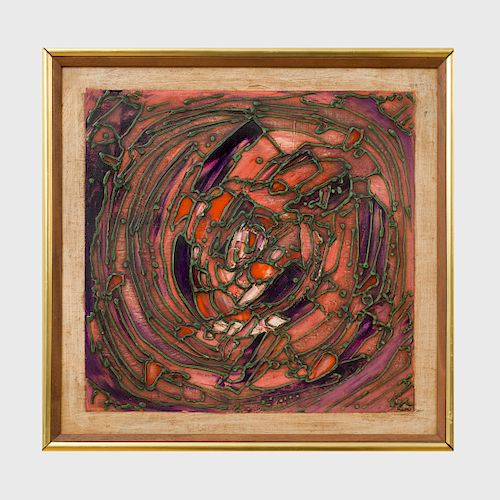Charles Seliger (1926-2009): Untitled
Bid Increments
| Price | Bid Increment |
|---|---|
| $0 | $25 |
| $200 | $50 |
| $500 | $100 |
| $3,000 | $250 |
| $5,000 | $500 |
| $10,000 | $1,000 |
| $30,000 | $2,500 |
| $100,000 | $5,000 |
Oil on board, 1962, signed 'Seliger' and dated lower right.
10 x 10 in., 10 3/4 x 10 3/4 in. (frame).
Note: Throughout his sixty year career as a painter, Charles Seliger (1926-2009) explored the unconscious of the natural world through interlacing lines and overlapping forms on a small, poetic scale. Never academically trained, Seliger was committed to the methodology of the Surrealists and the idea automatism, the belief that the artist’s undirected hand could conjure the unconscious. In 1943, Seliger met Jimmy Ernst, son of Surrealist artist Max Ernst, and through their friendship met and began to show his work with the Abstract Expressionist artists at 67 Gallery and later at Peggy Guggenheim’s Art of This Century Gallery. Guggenheim gave him his first solo show there in 1945 when Seliger was only nineteen.
Seliger produced no more than ten paintings a year, working slowly and methodically to create the intricate tracery that forms a color web in much of his work. His early work often depicted botanical forms, while his later work became more intense and focused on abstract compositions. In a 1945 artist’s comment for an exhibition at the David Porter Gallery, Seliger said that he wanted his “brain to become a magnifying lens for the infinite minutiae forming reality. Growth is the poetry of all art.”
Seliger showed his work steadily throughout his career and was represented by major dealers. The Museum of Modern Art bought his painting Natural History: Form Within Rock in 1946, helping to establish him in the New York art scene. In 1948, he was given his first important museum exhibition at the De Young Memorial Museum in San Francisco. He then joined the prestigious Willard Gallery. In 1986, The Guggenheim Museum exhibited a retrospective of his work. All the while, Seliger worked full-time at a commercial china company in Westchester County, NY where he began as a decal artist and retired as an executive vice president in 1993.
Early in his career, Seliger began to record his observations about art, the art world and his own ideas about painting. Having dropped out of school in the tenth grade, he was mostly self-educated and an avid reader of history and science. He donated one hundred and forty-eight notebooks and journals to the Morgan Library in 2005.







